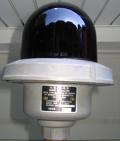|
A ship in a formation may receive the signal, "Nancy
Hanks" by TBS which meant, "Stand by for message by infrared
signal light". The signal was sent by a 12" signal
searchlight or 300W train lights equipped with infrared
filters that made the signals invisible to the naked
eye. It was received with a US/C-3 infrared
telescope.
Bill Henneberry, Chief Warrant Officer USS Trenton,
reported to me that his ship was equipped with Nancy equipment
in fall 1944 while in the Aleutians.
This link takes you to the Military Electronics page of
my website about my grandfather's work at RCA. He worked
on the 1P25 tube and the other hardware used in the
telescope:
This link takes you to pictures of my US/C-3 telescopes
and servicing them:
TRANSMITTING EQUIPMENT
Infrared transmitting equipment generally
consisted of incandescent lamps with infrared filters.
The higher-powered shipboard equipment used glass filters
(Corning 2540), which were rugged and eliminated all trace of
visible light. The handheld lamps such as used on the
snooperscope and sniperscope used a plastic (Polaroid XRX)
filter.

|
| US/X-12 infrared train
light |
The US/X-12 Infrared Train light uses a
300-W, 120V bulb. The filter is made by Corning.

|
| US/X-9 Infrared
Beacon |
The X-9 beacon uses a 12-volt, 8-Amp bulb in
a hemispherical filter. It is mounted on a 6-foot
stanchion. A control box allows continuous illumination,
local keying, or automatic keying with an external
keyer.
This seems appropriate for small
vessels.

COMMUNICATIONS BY MODULATED INFRARED BEAMS
It was recognized that thermal inertia
when turning an incandescent bulb on and off, and mechanical
inertia when operating a shutter imposed a
limitation on sending speed of about 12 WPM with blinking
lights and signal searchlights. Schemes were conceived
by which a Cesium vapor tube, with spectral lines at 852 and
894 nanometers, could be modulated at audio frequencies.
A receiver based on a thallous-sulphide cell received the
modulated waves and keyed an audio oscillator, allowing
sending rates equal to radio, up
to the limit of the operator (about 30 WPM). This
technology was working in the lab during the war, but I
think it was not deployed before the end of the war.
REFERENCES
G.A. Morton and L. E. Flory, "An
infra-red image tube and its military applications," RCA Rev.,
Vol. 7, pp. 385-413, 1946.
Zworykin, V.K. and E. G. Ramberg,
"Photoelectricity and its Application," John Wiley & Sons,
New York 1949.
J. M. Fluke and N. E. Porter, "Some
developments in infra-red communication components, "
Proc. Inst. Radio
Engrs., Vol. 34, pp. 876-883, 1946
N.C. Beese, "Cesium vapor lamps," J. Optical
Soc. Am., Vol. 36, pp 555-560, 1946.
|